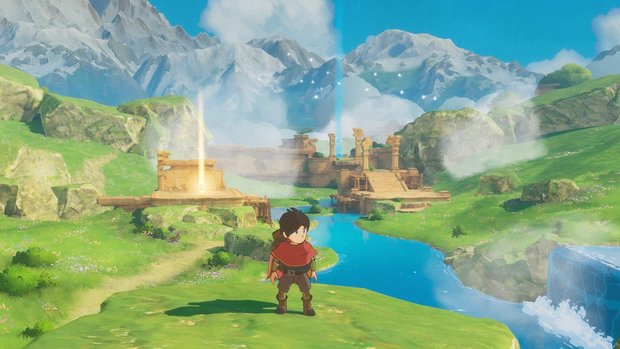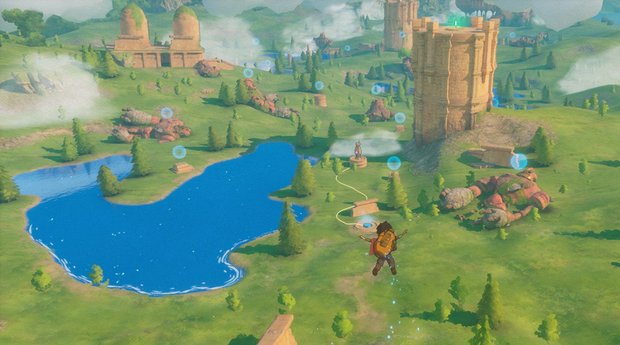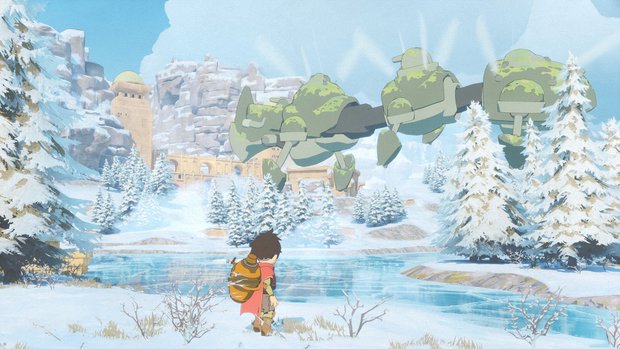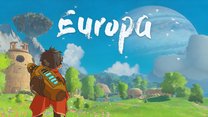Europa review

- 0 Comments
Gorgeous watercolour adventure won’t pose a challenge but soars as a gentle, relaxing experience that’s both fun and contemplative to play
I’m generally leery of games that refer to themselves as “meditative.” Often that word can be code for “mind-numbingly slow,” “gameplay that’s barely a rumour,” “impenetrable artsy-fartsy story,” or some combination of the above. So it was with a little trepidation that I launched into Europa, balanced out by the enthusiasm I felt for playing such a gorgeous-looking game that seemed like my kind of hands-on adventure. Much to my surprise and delight, there is truth in advertising sometimes, as the experience is genuinely relaxing, but with enough to actually do to keep you pleasantly occupied for the four or so hours it takes to complete, while still managing to effectively deliver a powerful underlying message. If it’s challenge you’re after, you won’t find much of that here, but if you’re looking to unwind, center yourself and have a good time doing it, Europa will give you a lift, in more ways than one.
The game gets its name from the moon where it takes place, but this is no icy rock body like Jupiter’s own Europa as we know it. Maybe it was once, but over a millennium it’s been terraformed by mechanical animal creatures known as “gardeners,” whose collective efforts have turned it into a thriving, vibrant paradise of meadows, lakes, mountains and waterfalls. It was meant to be humanity’s second chance, and by all outward appearances it seems at first that they succeeded. Alas, appearances can be deceiving, and gradually it becomes clear that all is not right in this supposed utopia, as evidenced by the fact that no one lives here anymore – except, curiously, you. The gardeners remain, still blissfully tending the moon’s idyllic, picturesque landscapes, but it seems all the humans have long since moved to a floating island in the sky, never to return, leaving only broken, decaying ruins in their wake.

Players control a young boy named Zee, whose journey to the island is guided by scattered diary pages wonderfully narrated by his father Adam. Unfortunately, Adam is now deceased, so these pages are all that’s left of him, detailing the history of the Europa experiment and Zee’s own childhood in insightful detail. Normally I might bristle at such an implausible storytelling vehicle, but that wouldn’t be very meditative of me. Besides, the tale is so thoughtfully conceived that you’ll be eager to collect each new page in your travels to see what happens next. It’s not all lightness and rainbows, either – far from it, as it speaks to the destructive consequences of mankind’s strained relationship with nature. But its tragedy is always infused with hope, and its future is clearly tied to the fate of Zee himself, so it’s easy to feel invested in it. Heck, I’m just glad it’s actually told in a clear, intelligible manner, rather than making us cobble together vague interpretations from overly cryptic artwork and obtuse symbols like so many games do.
Actually, the diary isn’t the only thing Adam left behind, as he also provided Zee with a jetpack called the Zephyr. This is a crucial tool in allowing you to levitate, glide, and even fly. You’ll probably spend as much time in the air as possible, not only to soak in the gorgeous painterly scenery from above, but because it handles so smoothly and is just so darn liberating. Of course, to do that you’ll need to continually replenish its power, in the form of respawning energy pools or spheres. In some levels these are liberally sprinkled throughout, while in others they’re rare and in some there will even be obstacles that actively hinder flight, such as purple crystals that abruptly deplete the Zephyr. Large energy crystals, on the other hand, will not only refill your energy supply but upgrade the jetpack with increased capacity. When forced to the ground, Zee will jog as fast as his little legs will carry him, but he’ll hoist himself over any manageable obstacle on his own with a cute little prepubescent grunt, playfully slide down slopes, and even an empty jetpack allows him a little charged-up power jump for an extra boost. Combined with a “glide” function that uses no juice at all, this lets you skim low over many surfaces without your feet having to touch the ground.

All this can be done by either gamepad or keyboard/mouse, but while the latter works just fine, it’s more comfortable with a controller. Either way, there aren’t a lot of different commands, as this is a very basic game with only a few distinct components, used in just enough different ways to keep the experience feeling relatively fresh. Exploring, of course, is central to the experience, although each of the game’s fifteen chapters is self-contained and the areas within them are sometimes broken up into sub-sections that are never particularly big. The levels themselves aren’t linear, but if you ever wander too far astray, a sudden gust of wind will push you back on course. The goal is ultimately to reach the exit and move on, but most levels are designed to make you stop and smell the roses. Or at least to clamber over hulking fallen sentries resembling the Iron Giant, or whisk up to ruined towers to see what secrets they reveal of this once mighty but now fallen human civilization that came before you.
Some massive doorways will require you to find and activate a series of scattered stone blocks or lanterns, while others demand that you collect wisps of light and take them to the exit. Seeking them out is a joy, but certain elements are marked by sky-high beams of light to make finding them even easier. In the case of the diary pages this wasn’t unwelcome, as I didn’t want to miss any (I didn’t), but other times it did feel a bit like overkill that might have been left as an optional feature at most. The rare occasions I actually had to search for a stubbornly hidden element ended up being the most rewarding. (Although even then, the notion of “challenge” is very much relative. Most sub-levels take mere minutes to complete.)
More challenge comes in the form of a series of environmental block puzzles to cross gaps or reach higher platforms when flight is not allowed. There are several different iterations, depending on colour: blues automatically disappear and reappear at regular intervals, yellows will do the same but only when you perform a jump, and purples will rotate the nearest block around the one you’re currently occupying. There’s slight dexterity involved, but as far as puzzle-platforming goes, this is about as forgiving as it gets, making Europa suitable even for those normally allergic to action games. As you progress, the puzzles get a bit trickier, like having to maneuver the rotating blocks to harder-to-reach touch points without colliding with something solid, but even then, the difficulty is still fairly mild.
As if to underline the game’s ease, Zee can’t die. I guess technically he can, like if you botch a purple block puzzle and plummet into the mist below, but all that happens is a fade-to-white and an instant restore so quick it won’t feel like death. Normally, though, even that won’t happen no matter how hard he lands from a fall or how many bombs hit him. Zee will be staggered and woozy and slow for a minute until he shakes off the… wait, BOMBS?! That doesn’t sound very meditative! Indeed it doesn’t, but for reasons that will become clear, the moon now has some defense mechanisms such as laser turrets, abundant proximity mines and annoying cannon creatures that will target you as soon as you enter their vicinity. They’ll helpfully light you up first to warn you of incoming fire, and it’s often possible to escape, but the cannons in particular can be relentless when they’re clustered together. Get hit by one and you may be in for a barrage as you can’t easily escape the next wave in your weakened state.

At least (most of) the turrets can be shut down by deactivating their nearby power switches; the cannons just keep firing. And since you can’t die, there’s really no penalty for failure beyond briefly slowing you down. However, Europa offers a “Zen” mode that will deactivate enemy threats. It seems odd to suggest using it when there’s so little challenge otherwise, but when I went back and replayed a few parts, I found it even more enjoyable to do so in peace. It’s not that avoiding defenses is hard, it just isn’t fun. And though it does fit within the story, it seems out of sync with the rest of the gameplay experience, so why bother? Fortunately, you can choose Zen mode for individual chapters should you want to go back and search for missing collectibles. I found only 19 of 40 crystals, and I thought I was being thorough! Apparently not. I think I missed one or two sketches for my bestiary as well, recorded along the way. It’s a shame the chapter select screen doesn’t indicate how many collectibles remain available for each level.
Collectibles or no, it’s tempting to spend more time on Europa just to appreciate the stunning sights: lush green hillsides, majestic brown ruins, puffy white clouds and piercing blue skies during the day that give way to dusky twilight and beautiful northern lights at night. There’s not as much location variety as I might have liked, but there’s an occasional diversion underground (still brightly lit) or to the top of blustery, snow-capped mountaintops. The one major detour is a scene that looks like it’s set underwater but isn’t, with its darkened sun-filtered backdrop, patrolling jellyfish-like creatures and towering florescent flora that resemble a kind of fungal kelp forest. It’s lovely, but where on earth did that come from? Well, I guess I answered my own question. It’s not Earth. Speaking of extraterrestrial environments, the occasional interlude will pop you through a portal for a quick, entirely linear foray into a trippy lightshow sequence that increases in brilliance as you progress, like visiting a digital representation of Avatar’s Tree of Souls. There’s really no narrative explanation for this, but thinking about it is messing with my chill vibe, so let’s move on.
Any individual scene in Europa is so screenshot-worthy, it’s hard to imagine it’s a 3D world and not a pre-rendered one. But thankfully it’s the former, as it looks wonderful in motion, too, like the swirling pools or dust clouds kicked up behind Zee that reminded me at times of The Legend of Zelda: The Wind Waker, though not as cartoony. Zee’s animations are polished and fluid, which is essential for capturing the feeling of flight, including the many spiraling updrafts and extended sequences of wind tunnels ridden like a slipstream. There’s always something going on in the background, too, whether organic (fish and foxes and frogs and flying whales!) to mechanical, including the colossal airborne guardians who resemble the invading leviathans in the Avengers movies (only here they’re nice, at least towards Zee).
All this is backed by a pleasant musical score that complements the mellow feel of the game, with synthesized or instrumental pieces of piano, strings, chimes and flutes that range from appropriately peppy to ominous thrums and sometimes almost reverently hymnal. Once in a while it feels a little overdone, but for the most part it’s content to linger in the background as atmospheric support. The sound effects play their part too in making Europa feel like a living, breathing world, with an ongoing ambient accompaniment of wind, wild critters, groaning waterwheels, and the ever-changing footfall beneath the young protagonist as he traverses grass, stone, and snow.
Final Verdict
If you’re the sort of person who likes to slow down and take time enjoying things at your own pace, you’ll probably fall in love with Europa. If you’re the type of goal-driven dynamo who sometimes forgets to appreciate the little things, then you’re probably someone who needs some Europa in your life. (If that sounds judgy, I confess I’m generally more the second type.) This is not a game to “beat” to feel victorious, but rather one to savour as the gentle, meditative yet still endearingly entertaining experience it is. Yes, it could use more variety, and yes, it could probably do with at least a touch more challenge to fully engage the right brain as much as it will the left. Plus I’m still a tad confused about part of an awkward finale. But ultimately these things are more quibbles than serious complaints about a game that largely succeeds at being exactly what it wants to be. If that sounds like your idea of a good time for a few hours, you’d be loony to pass it up.
Hot take
Not for those who seek challenge above all, but anyone who enjoys relaxing, contemplative experiences should feel over the moon about Europa.
Pros
- Gorgeously animated watercolour environments
- Soaring through the air is never NOT exhilarating
- Backstory is effective and told in a pleasingly coherent fashion for this sort of game
- As advertised in feeling relaxing and meditative
Cons
- Annoying cannon creatures are definitely not Zen
- Could use a little more variety of everything
Jack played Europa on PC using a review code provided by the game's publisher.











0 Comments
Want to join the discussion? Leave a comment as guest, sign in or register in our forums.
Leave a comment